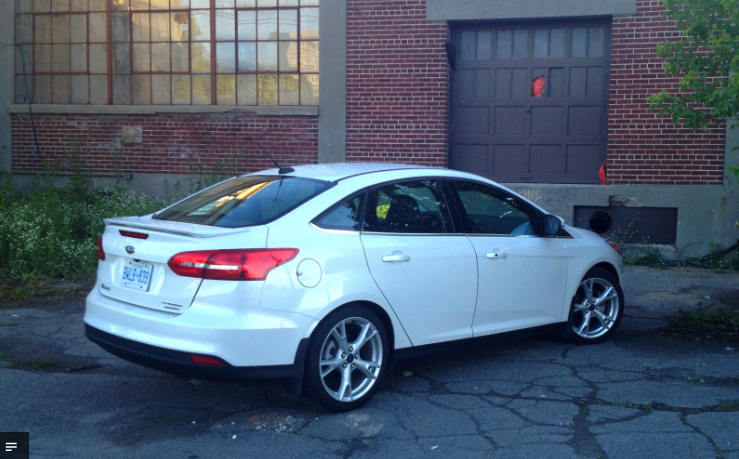Road Test: 2016 Ford Focus Titanium

Story and photo by John LeBlanc
The wealth of new automotive technologies found in modern cars can be a wonderful thing. Let’s say, for instance, you did not exactly ace the parallel parking portion on your driver’s test. That would not have been a problem if you were driving a new 2016 Ford Focus Titanium sedan.
By simply pushing a button, the Ford compact sedan’s sensors look for an open parking spot, then measure the distance to the curb and the surrounding parked cars. Once a parking space has been locked in, the driver signals to stop and accept the system’s assistance while the vehicle eases back into the parking space.
Pretty cool, eh? But you shouldn’t be too surprised. In top-of-the-line $26,499 Titanium form, my Focus sedan tester is a great example of the democratization of automotive luxury, where safety and convenience technologies formerly found exclusively in full-size luxury cars are becoming available in small cars, like the Focus, for a fraction of the price.
Like many of its mainstream rivals, Ford has been making technology available to the masses for some time. With such goodies like automatic high-beam headlight control, blind-spot warning system with rear cross-traffic alert and lane-departure alert, a 10-speaker Sony sound system, leather throughout the cabin and a heated steering wheel, the Focus Titanium certainly plays the role of the mini-luxury sedan, competing against other premium/mainstream compacts like the equally luxurious $27,995 Volkswagen Jetta Highline.
The current, third-generation Focus family debuted for 2011, although last year saw a refresh with a new front-end design that mimics the more expensive Ford Focus Electric. For 2016, the biggest Focus news items are the availability for the first time of an automatic transmission with the 1.0-litre turbocharged three-cylinder engine and the replacement of the old Microsoft-based MyFord Touch hands-free infotainment system with the new SYNC 3.
Developed by Canada’s QNX (a Blackberry company), SYNC 3 comes with a new eight-inch touchscreen that is quick to respond to inputs and a graphical design hierarchy that is more intuitive. Other new SYNC 3 features include the integration of AppLink (a way to control smartphone apps), Siri eyes-free capability for Apple iPhone, software updates via Wi-Fi, and enhanced 911 Assist for subscription-free emergency calling.
Thankfully, as much as Ford is cramming big car high-tech into its compact sedan, the U.S. automaker is also making it easier to use. The Focus’ central dash controls are more intuitive than in the past. A simple exercise, like tuning the radio, is no longer an act of frustration.
The other area the Focus Titanium acts like a much pricier luxury sedan is the way it goes down the road.
The compact sedan’s Ford of Europe-designed suspension delivers a one-two punch of being both well controlled and comfortable. Nary a rattle or vibration enters the Ford’s cabin. And thanks to laminated front windows and extra sound-deadening material introduced for 2015, this Focus is the quietest yet.
As much as the 2016 Focus Sedan Titanium feels refined, it’s also fun to drive. If not as taut as the sportier $30,749 Ford Focus ST four-door hatchback, the Titanium sedan is still enjoyable on a back road. The small Ford sedan’s steering allows it to nip into corners with a quick and linear response, despite the use of an electric power setup. The $500 18-inch wheels and tires provide plenty of cornering grip, and drivers will appreciate the Focus’ front seat – it supports well and still comfy after long drives.
Where Ford’s generous use of technology becomes measured is in the Focus Titanium’s powertrain. While the automaker brags about its technologically advanced EcoBoost engines, the most luxurious Focus gets a less than state-of-art naturally aspirated 2.0-litre four-cylinder that is simply “okay” in use.
Rated at 160 horsepower and 146 lb.-ft. of torque – 10 horsepower and 42 lb.-ft. below the Jetta Highline’s 1.8-litre turbo-four – the Ford’s power will not overwhelm. The run from zero to 100 km/h takes 9.2 seconds, or seven tenths slower than the Jetta.
The Focus is also thirstier than the VW; fuel economy estimates are 9.0 L/100 kilometres in the city and 6.2 on the highway highway for the Focus, whereas the Jetta chimes in at 8.2 and 5.6, respectively.
Subjectively, the Focus’ dual-clutch autobox lacks the high levels of refinement the Ford displays in so many other areas. Upshifts happen too early, and during both back road boogies and around-town toodling, the transmission never feels like it’s in the right gear.
In the end, for around the same money, drivers can opt for the Focus ST hot hatch and tree huggers can get a Focus Electric. But if you are looking for a compact sedan that offers a nice balance of ride and handling, a quiet interior and plenty of “big car” luxury goodies, the Focus Titanium is worthy of a test drive. Even if you can parallel park.





![[del.icio.us]](https://www.straight-six.com/wp-content/plugins/bookmarkify/delicious.png)
![[Digg]](https://www.straight-six.com/wp-content/plugins/bookmarkify/digg.png)
![[Facebook]](https://www.straight-six.com/wp-content/plugins/bookmarkify/facebook.png)
![[Google]](https://www.straight-six.com/wp-content/plugins/bookmarkify/google.png)
![[Reddit]](https://www.straight-six.com/wp-content/plugins/bookmarkify/reddit.png)
![[StumbleUpon]](https://www.straight-six.com/wp-content/plugins/bookmarkify/stumbleupon.png)
![[Twitter]](https://www.straight-six.com/wp-content/plugins/bookmarkify/twitter.png)
![[Email]](https://www.straight-six.com/wp-content/plugins/bookmarkify/email.png)